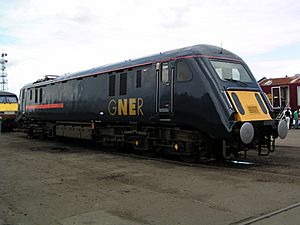British Rail Class 89 facts for kids
Quick facts for kids British Rail Class 89 |
|
 |
|
| Class 89, no. 89001, at Doncaster Works open day on July 27 2003. This locomotive has now been bought by the AC Locomotive Group. | |
| Power type | Electric |
|---|---|
| Builder | BREL Crewe Works |
| Build date | 1989 |
| Total production | 1 |
| Configuration | Co-Co |
| UIC classification | Co'Co' |
| Gauge | 1,435 mm (4 ft 8 1⁄2 in) |
| Minimum curve | 80 m (260 ft) |
| Length | 19,800 mm (65 ft 0 in) |
| Locomotive weight | 105 tonnes (103 long tons; 116 short tons) |
| Electric system(s) | 25 kV AC |
| Current collection method | Pantograph |
| Top speed | 125 mph (201 km/h) |
| Train heating | Electric Train Heating index: 95 |
| Locomotive brakes | Air & Rheostatic |
| Locomotive brakeforce | 50 long tons-force (500 kN) (Rheostatic) |
| Train brakes | Air |
| Career | British Rail, GNER |
| Number | 89001 |
| Axle load class | Route availability 6 |
| Disposition | Now preserved by the AC Locomotive Group |
The Class 89 is a prototype design for an electric locomotive. Only one unit was built, no. 89001, which was officially named Avocet by the then Prime Minister Margaret Thatcher on January 16 1989 at Sandy, Bedfordshire - the home of the Royal Society for the Protection of Birds (whose logo is an avocet). It was built in 1986, by BREL at their Crewe Works, and was used on test-trains on both the West Coast Main Line and East Coast Main Line. It was fitted with advanced power control systems and develops over 6,000 bhp (4,500 kW). It was given the nickname "Aardvark" although the railfans used to call it "The Badger" owing to its sloping front ends.
Images for kids
-
89001 in original InterCity livery at Eaton Crossing
-
89001 at Barrow Hill Engine Shed in September 2011



